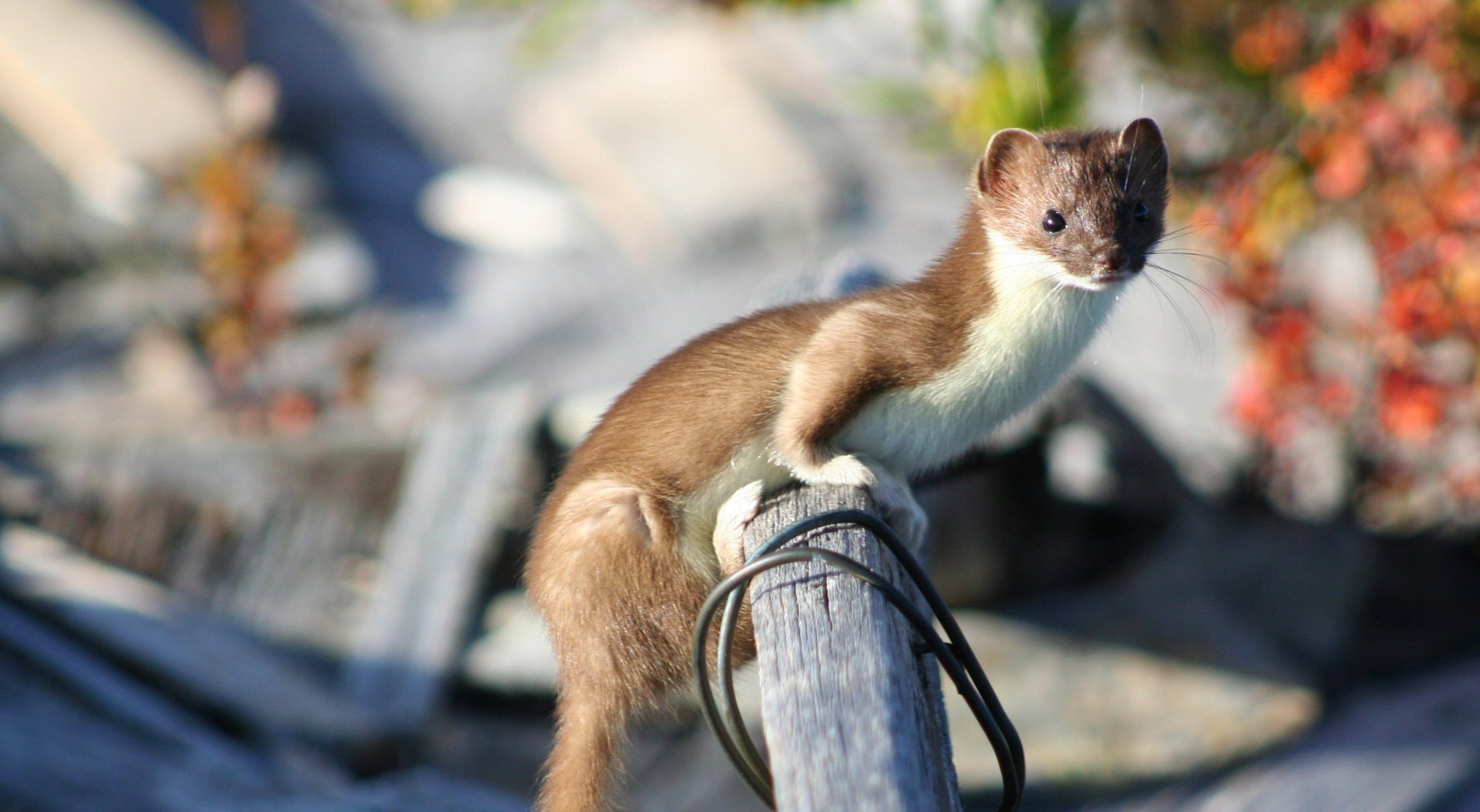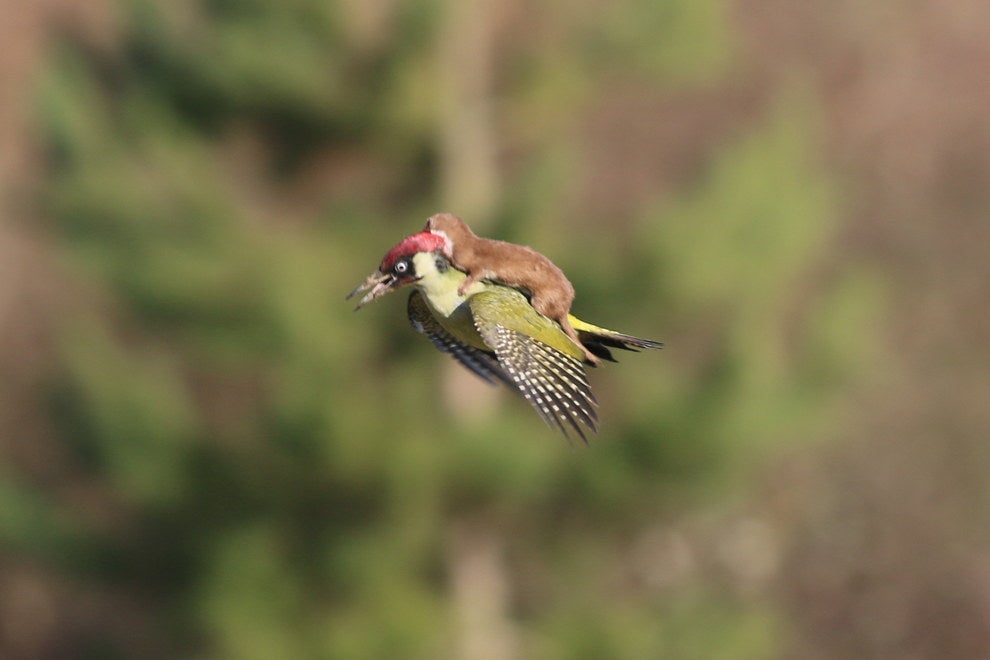You never knew you were obsessed with weasels until one flew on the back of a woodpecker
At first glance, it appears to be the world’s weirdest PhotoShop job. Or a still from an absurdly lifelike Pixar movie. But it’s very real: On Monday, Mar. 2, British photographer Martin Le May captured an incredible, real-life image while strolling through a park in East London—that of a baby weasel astride the back of a green woodpecker, holding on for dear life, like a miniature (and stupidly adorable) rendition of Bastian and Falkor from The NeverEnding Story.


At first glance, it appears to be the world’s weirdest PhotoShop job. Or a still from an absurdly lifelike Pixar movie. But it’s very real: On Monday, Mar. 2, British photographer Martin Le May captured an incredible, real-life image while strolling through a park in East London—that of a baby weasel astride the back of a green woodpecker, holding on for dear life, like a miniature (and stupidly adorable) rendition of Bastian and Falkor from The NeverEnding Story.

Naturally, a slew of memes followed:
The internet has an inexhaustible appetite for images of tiny animals doing winky things. We know this. But, in the case of our aerial mustelid, there’s far more than meets the eye.
That weasel is trying to murder that woodpecker.
How do we know? It’s all in the form. Though this fearless little flier appears to be gently nuzzling the neck of his winged steed, it is more likely trying to gnaw through its spinal cord. Even the tiniest of weasels—Mustela nivalis, or “the least weasel,” weighing in at an average of five ounces—are bloodthirsty carnivores. And their preferred method of attack is a devastating bite to the neck, severing the jugular vein; after which it will unceremoniously drag the carcass back to its den. Like a tiny jaguar.
“The green woodpecker is a ground-feeding bird, but weasels normally attack rabbits. The woodpecker is not its usual prey,” naturalist Lucy Cooke told BBC News, explaining how the event likely played out. “But weasels are fearless. A female weasel weighs less than a Mars Bar but is as ferocious as a lion, so this is why the woodpecker would have been able to take off with it on its back.”
The inevitable virality of ostensibly cute animals doing ostensibly cute things aside, what you should take away from the photograph is this: be more like the weasel. Yes, being “weaselly” has a definitively negative connotation but, in light of Mr. Le May’s revelation, I’d argue for a complete rebranding of this unfairly maligned, utterly misunderstood creature.
The weasel is outlandishly tenacious, considering its size compared to… well, almost everything. It’s a trait shared with some of its equally overconfident cousins. Witness this mongoose take on three African lions:
Certain Native American nations self-ascribe animal totems, usually intended to represent hereditary or tribal affiliations. There is also a rich history of wildlife-inspired symbology woven throughout the narrative traditions of many tribes. The internet, as it is wont to do, has bastardized these traditions, giving birth to a lamentable trend of declaring someone or something your “spirit animal.” As in, “Betty White is totally my spirit animal.”
If you must claim a “spirit animal,” look not to nonagenarian comedians, as admirable as their spry state-of-mind may be. Look to the weasel! Whenever you are faced with a seemingly insurmountable task or obligation, at work, or in day-to-day life, think of Mustela nivalis. Visualize it flinging its tiny form onto the broad (comparatively speaking) back of a green woodpecker, hurtling through the air, its tiny teeth buried in a dense layer of oily feathers. Forget such tired similes as “corporate shark” or “boardroom lion.” Be the boardroom weasel.
Sharks and lions make spectacular kills by default. We know this from an endless supply of nature documentaries. But weasels do too, though in arguably far more spectacular fashion. Watch this stoat—an even closer relative to the weasel than the mongoose—take down a full-grown rabbit more than twice its size:
What makes the weasel special is its dual function. As bold as some of its kills are, it also does important, albeit less impressive drudge-work—namely, pest control.
Though few weasels would pass up a chance at a meal of rabbit or woodpecker, their primary food source is mice. In areas where they haven’t been over-trapped or hunted, weasels are seen as ecological linchpins—all-natural mousetraps. Oecologists like Thomas and Druscilla Sullivan (scientists who study the various relationships between organisms in a shared ecosystem) have concluded that reintroduction of native weasel populations to areas suffering from mouse-overpopulation is a healthier, more environmentally friendly alternative to poison baiting. They’ve even proposed that manufacturers bottle “weasel odor” for sale as organic mouse repellent.
In conclusion, be the weasel. In business, in love, in life. Do the work that needs to be done, but take all opportunities to punch above your five ounces. Jump that woodpecker.